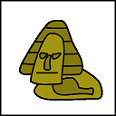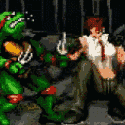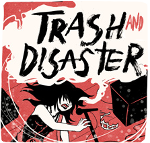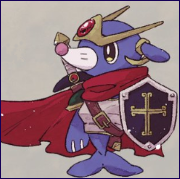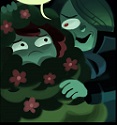|
CodfishCartographer posted:I think gerrymandering has tons of potential for games! There’s a mobile game that I think is just straight-up called Gerrymander that could be a good jumping off point for you. There’s tons of different ways you could take the game if you wanted - one player gerrymandering and the other converting citizens, both players doing both, citizens converting randomly, etc. 2v2 bridge style, very little communication allowed. One player does the actual campaigning, one does the redistricting. Since the time-scale on elections/redistricting tend to be so different, have there be like 4 "elections" i.e. scoring rounds.
|
|
|
|

|
| # ? May 31, 2024 14:05 |
|
A few weeks ago I had had a very different gerrymandering idea, inspired by Alchemists and its app. It involved regions having bar-coded face-down cards representing the voters, who you then need to poll to gain information on. Depending on the type and cost of the poll it can be more or less accurate, private or public, and it can be at city/county/state level. Obviously your design is significantly more feasible  . .
Dancer fucked around with this message at 22:42 on Mar 6, 2018 |
|
|
|
I'm just glad people see the inherent game design behind cheating the democratic system. I think boardgames can stand to be a little bit cheeky in their mechanics and theme.
|
|
|
|
Dancer posted:A few weeks ago I had had a very different gerrymandering idea, inspired by Alchemists and its' app. It involved regions having bar-coded face-down cards representing the voters, who you then need to poll to gain information on. Depending on the type and cost of the poll it can be more or less accurate, private or public, and it can be at city/county/state level. Obviously your design is significantly more feasible You could probably retool this to be done without an app somewhat easily. You could take some crib notes off of Argent The Consortium; the game board could be covered by a grid of face-down voter cards, and as an in-game action or reward players could peak at a voter to learn their preference. In Argent players place a personal token onto voters so they could be checked at will, but I could also see an alternative done for Gerrymandering where you just need to try to remember who votes for what. Obviously you couldn’t have each voter change their mind like you could with an app, but you could kind of work around that - have voters move locations, be able to “sway” voters and thus change their color at will, etc.
|
|
|
|
So, cooperative games generally tend to be quite difficult. What is it that makes them so difficult? Obviously it varied from game to game, but are there running themes you’ve noticed? I feel like a lot of it is having way way way too many things to deal with, of varying priorities, and trying to balance dealing with as many as possible. Trying to avoid being overwhelmed. Would you guys agree, or is there other stuff that tends to make them particularly hard? tl;dr: I’m designing a co-op game and it’s quite a bit easier than I’d like, even on a first play, so I’m trying to think of ways to adjust the difficulty without making it entirely up to luck 
|
|
|
|
CodfishCartographer posted:So, cooperative games generally tend to be quite difficult. What is it that makes them so difficult? Obviously it varied from game to game, but are there running themes you’ve noticed? I feel like a lot of it is having way way way too many things to deal with, of varying priorities, and trying to balance dealing with as many as possible. Trying to avoid being overwhelmed. Would you guys agree, or is there other stuff that tends to make them particularly hard? I'm not super happy with how most co-ops are balanced. It normally boils down to: "You're playing a game where the sides are completely imbalanced - if you were against a thinking opponent it would be completely impossible. However, because your opponent moves randomly, it might end up being a fair fight. Or way too hard or easy. Who knows." I think this is a thing that could really use some fresh ideas, but it's definitely not an easy problem. I think the AI (and difficulty tuning knobs) in Gloomhaven ended up working pretty well, but it was still hard to keep the difficulty in the "sweet spot" over a campaign - and we still had missions that were way too easy or hard based on how the AI behaved. On the other end, apps offer much more interesting co-op opponents - but they demand a bunch more work (on both the design side and often the player side).
|
|
|
|
I think the question isn't really about co-op but about player vs mechanical opponent - the number of humans on the 'player' side does not seem relevant. That widens the domain of potential answers to solitaire games as well. And to answer, I'm not aware of any such games where the opponent or game does not largely hinge on a random component. Disposable puzzle games probably come closest?
|
|
|
|
|
CodfishCartographer posted:So, cooperative games generally tend to be quite difficult. What is it that makes them so difficult? Obviously it varied from game to game, but are there running themes you’ve noticed? I feel like a lot of it is having way way way too many things to deal with, of varying priorities, and trying to balance dealing with as many as possible. Trying to avoid being overwhelmed. Would you guys agree, or is there other stuff that tends to make them particularly hard? To your design: Think about what knobs you have to tune the balance. For concrete discussion here it's tough to offer help without some knowledge of what mechanics are available to tweak and what strategies are winning too easily. Talk to your playtesters about which decisions are total no-brainers and see if there's a way to make those spicier. What makes them difficult: Common elements are a time limit, players rarely-to-never having a perfectly efficient answer to a given obstacle, and just generally oppressive goals they're trying to accomplish. Every point the players have to make a difficult choice is a chance for them to communicate, learn something about the game, and hammer out the perceived correct course of action. This is reductive but think of coop games like a puzzle with a fail state(s). It's way too much to ask a person to flowchart every single move and register how many lines of play result in a victory vs defeat (literally billions of states to examine), but if there's one function or mechanic in your design that's predominantly deciding wins and losses that's a good place to start tuning. It isn't coop but in our design we realized that a specific action was indirectly causing another action to become overpowered and wrestled with the symptom instead of the cause for like, 3 drafts before we noticed what was actually going on. Now it's a neat little combo instead of a free win once it comes online. I agree 100% with Osmosisch about the number of human players being irrelevant to game state. The only thing that kind of matters is if there's closed information but that's easily ignored (though not necessarily recommended for fun/balance). Pandemic and pals all sort of wind up back at solitaire, being puzzles to be solved. Again, I don't know the specifics of your game but you might try to math out how many if any unwinnable or imperfectly winnable initial states your game has, at least to a reasonable degree. That's worth paying attention to and may give you some insight as to why your game is too easy. Some examples: Klondike solitaire has a 1-4000 chance of having 0 moves available on deal (all red or black, all evens available, etc. State 0 game loss. Assuming perfect information (all cards known), there's ~21% unwinnable hands in all possible deals. Hanabi does the inverse of this: The way the game is structured allows for ~95% of games to be completed with a perfect score. Somebody even wrote a paper about it. Forgive the fishy link, drive is weird about PDF links sometimes: https://sites.google.com/site/rmgpgrwc/research-papers/Hanabi_final.pdf?attredirects=1 Comedy option: Get it to the point that people say it's fair and ratchet it up one more degree of difficulty like Shadowrun Crossfire and call it a day.
|
|
|
|
Hey all. Haven't posted about my designs here in a while, but I figured I'd close the loop: Meltwater: A Game of Tactical Starvation will be available from Hollandspiele this summer. quote:“Restraint? Why are you so concerned with saving their lives? The whole idea is to kill the bastards. At the end of the war, if there are two Americans and one Russian left alive, we win.”
|
|
|
|
That sounds fantastic, congratulations!
|
|
|
|
Got my box wrap finished to send off to the Kublacon design contest this year. This wrap went a hell of a lot better than my last attempt at this sort of thing. Rulebook is done, cards are done, components are done... oh, there probably needs to be a bottom half to that box. poo poo.
|
|
|
|
Gutter Owl posted:Hey all. Haven't posted about my designs here in a while, but I figured I'd close the loop: Congrats! Fix posted:Got my box wrap finished to send off to the Kublacon design contest this year. This wrap went a hell of a lot better than my last attempt at this sort of thing. Is that art from somewhere, it looks familiar for some reason I can't quite place. Also have you talked about this game before?
|
|
|
|
Anniversary posted:Congrats! I've not. Been keeping it a bit under wraps, to be honest. I was intending on shopping this project for a particular license, and we're going to see where that road goes in a little while. The artwork is all original, painted by a friend of mine. He did the box and card art that particular piece he finished yesterday, so I'd be surprised, to say the least.
|
|
|
|
Fix posted:I've not. Been keeping it a bit under wraps, to be honest. I was intending on shopping this project for a particular license, and we're going to see where that road goes in a little while. Huh, it must just be a stylistic resemblance to something I've seen then. Looks great! Hope it goes well. 
|
|
|
|
Thanks. You and me, both.
|
|
|
|
So I've been continuing to refine Contract. Have a rough rulebook written up and everything for once. I also have a designer who I got in touch with, as they were a friend of a friend, giving me some feedback which is really helpful. I've made a few changes recently, making Contracts unique-ish and something you collect when you score has tested really well and new assets seem to be, with a handful of troublesome exceptions, in a good place. There's been a lot of power creep since early designs, but I think everything is decently internally balanced as I've continued to update early designs to fit the current paradigm. quote:Game Objective quote:Set Up Fix posted:Thanks. You and me, both. 
|
|
|
|
So I’m working on a coop game using cards and dice to fight a boss. I want there to be big flexibility with when card abilities can trigger, but I’ve run into a problem where cards have become unclear on when they can trigger, in what order, etc. I’ve decided to include some symbols on cards to try to make this easier to understand, but I’m not sure how best to do so. For reference: Each card has a stamina cost, and gives you a number of dice to roll in order to deal damage (or gain other effects, such as healing or card drawing, etc). There are four main phases where card effects can take place: When playing cards(🃏), when rolling dice(🎲), when dealing damage after rolling dice(⚔️), and when the boss is doing things (👿) (the little mt fuji symbol is a reference for the Petrify effect) Mockup 1: Including a brief timeline on each card to show the order of phases, and highlight / mark which phase the card occurs in:  This is pretty clear in terms of when a card takes place, and doesn’t really require tons of learning what order symbols come in or anything like that since it’s spelled out. I can include multiple arrows to indicate when a card can take place during multiple phases, but the player needs to choose which one to use. Mockup 2: include a symbol of which phase the indvidual ability activates in, next to the ability text:  This clears up most ambiguity of when an ability occurs, and gives more flexibility than the above in that one card can have different effects in different phases. However, it’d require players to learn when the phases take place (a reference card would help with this) and maybe looks more cluttered? Especially with effects that CAN trigger during multiple different phases, but only triggers once, like the one above. I could cut down this clutter by designing each ability to only take place during one phase at a time, of course. I'd probably also need a symbol for when an ability takes place over an entire turn, such as "+1 Stamina when <thing not bound by phases> happens this turn" Not sure what that symbol would be, an infinity sign? A clock?? Or is there a third option I’m missing?? I’m looking for ideas! (also I’m still fiddling with the overall layout of everything, I’m mostly looking for feedback on how best to communicate the timing of card abilities)
|
|
|
|
I like the idea of all of them being present on every card (I'm a big fan of cohesive card templates), but instead of an arrow maybe try heavily fading out the ones which aren't relevant. Something like how Spirit Island displays its elements on the left side of cards.
|
|
|
|
Countblanc posted:I like the idea of all of them being present on every card (I'm a big fan of cohesive card templates), but instead of an arrow maybe try heavily fading out the ones which aren't relevant. Something like how Spirit Island displays its elements on the left side of cards. Ooh, the fading on those does look real nice! That's a solid idea. It would limit me slightly in that one card couldn't have two different effects that occur during two separate phases, but that might not be the end of the world. I worry a teensy bit that having multiple phases could confuse people towards an effect occurring multiple times, but maybe if I make it clear in the rules that wouldn't be a problem.
|
|
|
|
So, I've been looking again at working on "Lost in the woods". I mentioned it here a long time ago, and I never got super far in the design. What I want is a cooperative game about a group of kids lost in a mystical woods, trying to get home. Heavily inspired by "Over the Garden wall" and "Stand by me." I had the idea of scenarios where the players draw from a deck to determine odds and decide together whether it's worth it to accept or reject (for example, trust directions, or offers of lodging). These motive checks with a deck of cards, 10 black and 9 red. One card is drawn face down, and the 9 are drawn face up. The number of black cards if the odds times 10. I had a mechanic of describing clever use of items to get out of trouble, but I didn't like it because it felt far too lose. I'm still considering maybe some item set collection, like needing 2 or 3 foods at the end of each day, or lose morale, maybe. (I feel like there needs to be then some companion mechanic to go with that, making shelter and fire?) I feel like there needs to be individual tasks for the players, as choices, just deciding together the risk/reward thing is boring by itself, but I'm not sure what that is. I guess I sort of see this as something like the same type of game as Shadows Over Camelot, Forbidden Desert/Island or Pandemic. Or a co-operative Tokaido if that makes sense. I don't know how to progress with this design.
|
|
|
|
Codfishcartographer, I think it makes sense to have the main constraint/restriction be the primary element, so if you can only use a card in phases XYZ that should be the most immediately visible element. Assuming reading from left to right, that means the phases should be along the left edge, similar to the spirit island cards. If you're willing to give up space for art, I would simply make it so that each card has one row for each phase, and have the effects in those rows; a grayed-out/blank row would mean playing the card in that phase does nothing, or is not allowed.
|
|
|
|
|
Osmosisch posted:Codfishcartographer, I think it makes sense to have the main constraint/restriction be the primary element, so if you can only use a card in phases XYZ that should be the most immediately visible element. Assuming reading from left to right, that means the phases should be along the left edge, similar to the spirit island cards. Oh poo poo that's brilliant, I never considered putting the effects themselves aligned with the phases they occur in!
|
|
|
Glad you like it. Let us know how it works out!Foolster41 posted:So, I've been looking again at working on "Lost in the woods". I mentioned it here a long time ago, and I never got super far in the design. One way to divide cooperative games is between those where players portray a unique role with specific abilities/advantages and those where this is not the case. From my reading, your game falls in the latter category for now. This means that you need some other way to make players feel distinct. As an example, Hanabi manages this by making information aysmmetric - you only know the cards that other players are holding, not your own. I think a lot of your design will be influenced by where/how your game falls on this continuum. Are your kids uniquely good at something specific? Is their uniqueness mechanically more involved than getting +1 vs. ogres? Or is it more about everyone knowing parts of the route home, and you as a team needing to somehow piece this together from the players' disparate knowledge? A second question is whether your game is more about having the right pieces to solve a particular puzzle (e.g. Pandemic: can we clear the infection from city X before it overflows? Only if we have a Medic, but how do they travel there, etc.) or is it more about being efficient enough to meet whatever the challenge is without running out of resources? Your game does seem to have a clear goal (get home) so that's helpful.
|
|
|
|
|
Osmosisch posted:Glad you like it. Let us know how it works out! Made a quick mockup of a few different cards! Now that I’m looking at them, I think they’ll be perfect. Here’s just a general card that has two different effects in two different phases:  Here’s a card that has multiple effects in the same phase:  The only iffy thing is when a card has an effect that can be used in one of two different phases, and the player chooses which. I’m not sure what to go with: The abilities aligned to the top:  Or the abilities placed evenly between the two phases that it can be used in:  What do you guys think? maybe there’s a third option available for how to handle that problem? I suppose I could just design cards so that couldn’t happen, but there’s some fun effects that I’d be missing out on.
|
|
|
|
I'm not super familiar with co-op games that don't have unique roles, and I guess I'm afraid of players not having enough interesting things to do without roles. I had considered having abilities, based on personality traits. For example, stubborn who votes first on the motive checks. and you get some sort of bonus if you don't change your mind. Or Suspicious which allows you to spend some sort of resource to get another token as a clue for motive checks. I like the idea more than they have abilities, rather than bonuses, though abilities like allowing to trade items like most of this type of game, in this case, doesn't make much sense since they're together. I do like the idea of a feel of something like Pandemic, where it's a puzzle sort of like that. Perhaps I need to get more abstract in the way the game works, but I'm not sure how. E: One idea I had is scenerios are divided into "day" and "night", and during night scenerios players have to choose tasks to do (build the camp, gather firewood, get food) but can't communicate, and choose secretly, so it's about trying to choose different enough tasks, but that doens't make much sense with the theme. Foolster41 fucked around with this message at 19:37 on Apr 13, 2018 |
|
|
|
Foolster41 posted:I'm not super familiar with co-op games that don't have unique roles, and I guess I'm afraid of players not having enough interesting things to do without roles. I would recommend trying to think of what the overall experience you want to portray to the players is, and figure out the best ways to encourage that. Do you want a big focus on survival and trying to figure out ways to scrape by? Do you want it to be more about exploring a wilderness and the goal of “get home” is more of a guideline than a dire circumstance? Do you want players to need to work together but not necessarily trust each other? etc. Pinning that down can help you determine what mechanics will and won’t support that ultimate goal. You can also think of a few other “pillars” to build your design on - a focus on risk/reward management could be one, based on what you’ve posted so far. For some examples of how these changes can alter your design - if you want a focus on survival, making the players need many different resources (food, water, firewood, and then tools to gather all of those) that are hard to come by would work well, and would tie into the risk/reward of different events and encounters. It might also be good to think about what different goals the players will encounter while playing. And I don’t just mean a basic “get home” goal, but smaller ones that can be worked towards. For example, while playing MtG you have the ultimate goal of “win the game” but you might also have a goal of “play this combo of three different cards” or “get this enchantment out as quickly as possible” or “kill that creature before I play mine” or “get a reliable mana engine going” etc. With Pandemic there’s the goal of “get rid of the viruses” but there’s also tons of smaller ones that crop up - “we need to clear out Los Angeles before it spreads quickly” or “we need to prepare for the next crisis” or “we need to get our medic player to south america” etc. If you can get an idea of different goals you want the players to have, you can then design ways for players to accomplish those goals. Ideally there will be more goals than any one player can handle, thus encouraging the players to work together.
|
|
|
|
quote:Do you want a big focus on survival and trying to figure out ways to scrape by? Do you want it to be more about exploring a wilderness and the goal of “get home” is more of a guideline than a dire circumstance? Yeah, I guess my problem is trying to figure out what sorts of things those "small fires" like what happens in pandemic is. E: Someone on reddit reminded me of Orgon trail: the card game. I guess that's a sort of feel I want, but I've played it a few times and was a pretty badly over-random (to be fair, it emulates the video game well) mess. E2: I forgot to say too, I don't really want the idea of the group not trusting each other/ a traitor mechanic. Foolster41 fucked around with this message at 20:36 on Apr 13, 2018 |
|
|
|
I think you can pull off (semi) randomized places and characters fairly well without sacrificing replayability, it’ll just take a decent amount of work and creativity. I think if that’s the angle you want, maybe lean more in a storytelling game direction? Take a look at like Tales of the Arabian Nights or A Quiet Year for inspiration. Some large well of content to mix together randomly, or possibly some way for the players to create part of the content themselves.
|
|
|
|
With the "choose your phase" cards, I feel there's not really a way to cleanly convey it in the current layout. So why not cut the knot? How necessary is it that X effect can happen in one of multiple phases? Is there a way to make the specific card effect work in just one phase?
|
|
|
|
You could maybe color code the card borders or backgrounds and phases. For instance, phase 1 is blue, 2 is red, 3 is green etc. So a card that can trigger in phases 1 and 3 would have a blue and green border or background.
|
|
|
|
Sandwich Anarchist posted:You could maybe color code the card borders or backgrounds and phases. For instance, phase 1 is blue, 2 is red, 3 is green etc. So a card that can trigger in phases 1 and 3 would have a blue and green border or background. This could probably work, but... Gutter Owl posted:With the "choose your phase" cards, I feel there's not really a way to cleanly convey it in the current layout. ...After thinking about it, I think that cutting those effects is probably the best idea. Or at least, reworking them to not be so open-ended. I looked over the cards and there's only a handful that actually can be meaningfully used in different phases, and those could be reworked into having different effects for the different phases. It loses a teensy bit of depth, but it's not the end of the world for the clarity it provides. For example, with the card above the idea was you could use the effect on dice the players rolled, OR on dice the boss rolled. While I feel like that's a cool decision (especially if the player assumes it only effects one, but then later figures out they can use it on another), the difficulty in communicating it probably isn't worth the hassle. Especially since I could easily split the two effects, one for player dice and one for boss dice. I also use red/blue/green/yellow to signify dice and element colors, so I don't want to mix those colors up on the cards any further. I didn't mock that up much on the cards cus it was quick and lazy, but the wind card would be green and the fire card would be red, etc. I also made a bit more of a high-effort mockup, let me know what you guys think: 
CodfishCartographer fucked around with this message at 06:48 on Apr 14, 2018 |
|
|
|
Much cleaner, looks good. I'd tone down the border a little but otherwise fine.
|
|
|
|
|
Can I get some thoughts on this template for Contract? Feedback I've gotten from people who know graphic design better than I is that the color palette is inhibiting its legibility. So that's something I'd love feedback on as well as if the layout is intuitive / useful.  The number in the top left is the most important, its the cards Power, so its located there to be easy to see when fanning cards in your hand. Next to it is the cards name. The large blank space is for an eventual image. The text below that is ability text, in this case its a Hidden card (which is also clued in with the purple border, though I worry that might be a bit much). Finally the number in green is the cards cost. Unfortunately, that cost was causing a legibility issue, hopefully the much lighter green it now uses helps. Can anyone think of better ways to convey that information? I'm always interested in novel takes and recognize that being too close to the design can be limiting me. Osmosisch posted:Much cleaner, looks good. I'd tone down the border a little but otherwise fine. Agreed. I really like the iteration you've landed on CodfishCartographer! It's always frustrating losing design space, but giving it up to make ones design more intuitive usually seems worth it. Is this for the reimplementation of Behemoth you talked about a while ago? quote:yes, its roll and move. How can you move forward without it being luck based? This is my new life motto I think.
|
|
|
|
Leave the power where its at, put the cost below it in the top left corner, and have the card's name on the left edge going vertical. This way you can see all the relevant info for playing it while it is in your hand fanned with others.
Sandwich Anarchist fucked around with this message at 18:19 on Apr 14, 2018 |
|
|
|
Sandwich Anarchist posted:Leave the power where its at, put the cost below it in the top left corner, and have the card's name on the left edge going vertical. This way you can see all the relevant info for playing it while it is in your hand fanned with others. Oooh, that's a clever suggestion! Though you wouldn't have to move the cost, because as is you only pay the cost to buy the card from the offer into your hand, so while its fanned in the hand cost isn't significant. e: But moving the name is a real solid idea. I'm... not sure how do vertical text alignment in what I've been using for these, but I'll look into it!
|
|
|
|
Anniversary posted:Oooh, that's a clever suggestion! Though you wouldn't have to move the cost, because as is you only pay the cost to buy the card from the offer into your hand, so while its fanned in the hand cost isn't significant. I added an image to my post
|
|
|
|
Sandwich Anarchist posted:I added an image to my post Wow, yeah I really like how that looks.
|
|
|
|
CodfishCartographer posted:I think you can pull off (semi) randomized places and characters fairly well without sacrificing replayability, it’ll just take a decent amount of work and creativity. I think if that’s the angle you want, maybe lean more in a storytelling game direction? Take a look at like Tales of the Arabian Nights or A Quiet Year for inspiration. Some large well of content to mix together randomly, or possibly some way for the players to create part of the content themselves. I forgot about Tales of Arabian Nights (I rewatched the shut up and sit down review). The Quiet Year sounds really neat. The idea of some sort of book of flavor, like in ToAN is interesting. I guess the thing is, I can't decide how much a mechanical board game this is, and how much this is more a storytelling/roleplaying game it is. I keep going back and forth on whether or not I want the "action checks" (Having players describing how they use items to get a +1 to a check for each of the items). On the one hand, I feel like I can do more interesting scenarios with it, but on the other, I feel like it's going to not be interesting, thinking of how badly it works in Machine of Death. (I feel like there needs to be an adversarial/GM player to veto who doesn't have a stake in success, like in MoD). E: I guess the problem is, I feel like with a place and person description (from cards in the game) there's not enough info to be interesting describing how you escape.) I feel also like my scenarios are maybe far too generic, and I need to find a way to make them more specific. I'm trying to think of good scenarios, that don't revolve around combat since I don't want this game to be about combat. I have a little description and question with each one. So far the scenarios I have are:
Foolster41 fucked around with this message at 22:27 on Apr 14, 2018 |
|
|
Anniversary posted:Wow, yeah I really like how that looks. Please up the contrast between text and background. If you absolutely must have coloured (or even grey, ew) backgrounds behind text, at least apply a white outline to the text. Also as a mildly colourblind person, any game designer who doesn't distinguish things by more than colour alone goes on my enemy list.
|
|
|
|
|

|
| # ? May 31, 2024 14:05 |
|
If you enjoy CAH I think an important question to ask yourself is "What do I like about this experience? The game itself or the people I'm playing with?" I've played my fair share of CAH with friends but I'd rather do literally anything else and still laugh and joke and poo poo.
|
|
|










